Bald Beast of KI: It’s A Mink
Posted by: Loren Coleman on May 23rd, 2010
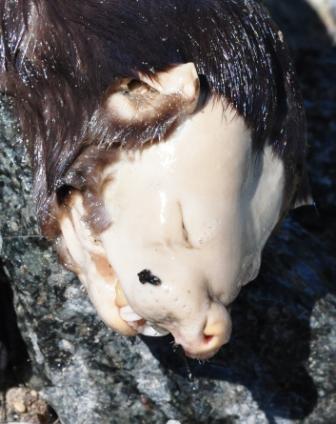
Things appear to go in cycles.
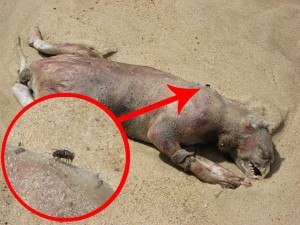
The Montauk Monster received so much publicity in 2008, it was inevitable that more washed-up carcasses would get their own share of media moments and minutes.

Although the Montauk Monster most assuredly turned out to be a raccoon, in the months that followed, more (briefly) unexplained decaying bodies turned up in the New York, the UK, Alaska, Panama, and elsewhere to befuddle the press.
The animals were discovered to be everything from marine mammals to an unfortunate sloth.
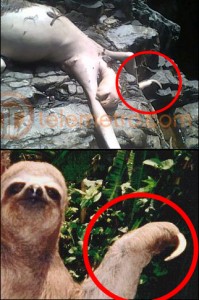
This year’s first candidate to be compared to the Montauk Monster, of course, has been the Bald Beast of KI, or the Kitchenuhmaykoosib monster (also called “Omajinaakoos,” “Big Trout Lake Monster,” and “The Ugly One”).
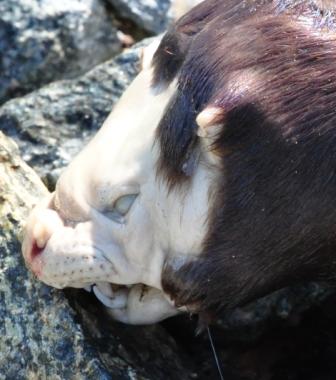
It was a dead animal (almost 12 inches or 30 centimeters long) that was discovered and photographed on May 8, 2010 by two female nurses and their dog in a creek on or near Kitchenuhmaykoosib Inninuwug First Nation, Ontario.
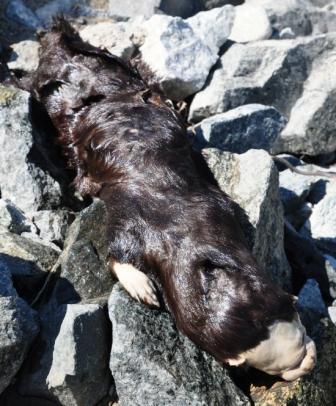
Some elders have said it is a creature called oomajinakoos (ugly one), the appearance of which is said to be a sign of bad luck.
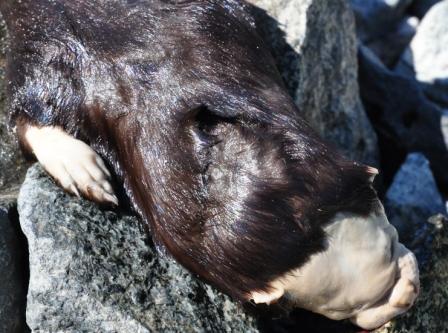
Beyond the unrealistic speculation that it was a relative of Ogopogo, Nessie, or even a baby Sasquatch, the more logical thinking has produced a mundane answer to this brief mystery. At first, thoughts moved in the direction of a bear cub, a muskrat, or an otter. But recent indications point to the animal having been a rather commonplace species, a mink.

The American mink, Neovison vison, are found throughout North America, in Canada and the United States of America. They are dark-colored, semi-aquatic, carnivorous mammals of the family Mustelidae, which also includes the weasels and the otters.
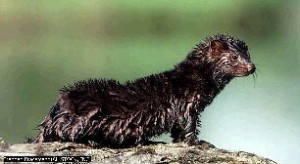
The well-known silky soft fur of a mink, when wet, can take on an even more intense glossy appearance. The head of a mink would look similar to that of an otter. The key are the feet, which are webbed in otter and unwebbed in mink.
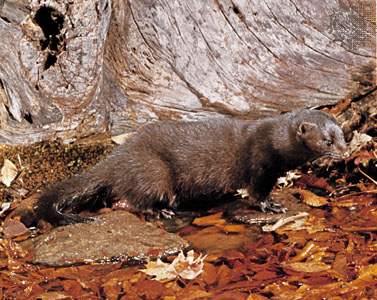
The American mink and its skull.
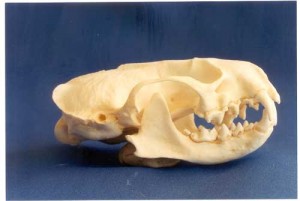
While some individuals writing to Cryptomundo have suggested the mink species specifically as the answer, let me quote from the opinion of an authority consulted by Forgetomori, via biologist Maria Guimarães, who shared the thoughts of James L. Patton, Curator and Professor Emeritus, Museum of Vertebrate Zoology, University of California: “[The] mystery critter looks more like a mink than an otter to me (longer fingers, without any evidence of webbing). It clearly was dead in the water for a prolonged period, hence the defurred face and head, and somewhat swollen appearance….If anyone had bothered to look at the teeth, the identification would have been easy, but….”
As Patton, Forgetomori, and all of us have noted, identification in such cases are difficult from web-posted photos, when more secure positive identification could have been obtained with an actual body. But we sometimes have to work with what we have. In the case of the Bald Beast of KI, once again, the actual carcass has disappeared. From what is available, the photographs a reportedly foot-long dead body pulled from a creek in Ontario, it appears to have been a dead mink.
About Loren Coleman
Loren Coleman is one of the world’s leading cryptozoologists, some say “the” leading living cryptozoologist. Certainly, he is acknowledged as the current living American researcher and writer who has most popularized cryptozoology in the late 20th and early 21st centuries.
Starting his fieldwork and investigations in 1960, after traveling and trekking extensively in pursuit of cryptozoological mysteries, Coleman began writing to share his experiences in 1969. An honorary member of Ivan T. Sanderson’s Society for the Investigation of the Unexplained in the 1970s, Coleman has been bestowed with similar honorary memberships of the North Idaho College Cryptozoology Club in 1983, and in subsequent years, that of the British Columbia Scientific Cryptozoology Club, CryptoSafari International, and other international organizations. He was also a Life Member and Benefactor of the International Society of Cryptozoology (now-defunct).
Loren Coleman’s daily blog, as a member of the Cryptomundo Team, served as an ongoing avenue of communication for the ever-growing body of cryptozoo news from 2005 through 2013. He returned as an infrequent contributor beginning Halloween week of 2015.
Coleman is the founder in 2003, and current director of the International Cryptozoology Museum in Portland, Maine.










We did some trapping here in Montana when I was little. I saw several mink in the process of skinning them, along with bobcats, coyote, bears, deer, elk, beaver, etc etc. People are just so far removed from death and the outdoors anymore. I ran across lots of mangled forms in the woods and along the roads. These days even Native people a lot of times are as citified as the rest of us (and I am Native myself). Today’s people can quickly tell the difference between many of the kinds of e-phones from a distance, the way some people into cars can call out makes and years of automobiles, or even parts of them (hubcaps etc). It’s just a matter of what your interests are and what you are exposed to, not just once or twice, but constantly. So not only tourists driving through at 70 mph, but even weekend hikers and hunters, will continue to come up with blobsquatches, nessie-logs, and mystery rotting beasts.
Ah the blobs…when I first fired off the link to Mr. Coleman I flippantly fired off otter, partly because I wanted to give something back to the blog and didn’t study it first and partly to give Loren a idea of what he may be looking at.
If there is one thing about these finds, its that I’m learning by studying the pictures and reading the discussions the pictures stir up.
After going back and studying the images and going to the Trout Lake website etc I ruled out otter and am pleasantly surprized I was close. I concluded mink or marten.
This indeed pleases me as for the past few years of coming here daily and reading such stimulating debate by all kinds of people both professional and layman, I find a lot of what’s presented here is sticking with me and deepening my love for this fantastic branch of science, recognized or not.
So thank you blobs whatever you are and also the authors and visitors to Cryptomundo…cheers!!! Pete
“From what is available, the photographs a reportedly foot-long dead body pulled from a creek in Ontario, it appears to have been a dead mink.”
Closure! Yet, I wonder where they take bodies that generate this much attention, and whether or not they are:
a) buried / cremated,
b) sold to a collector for funding,
c) provided to scientists for additional research
A mink seems really plausible. I already thought that the stated size would be a bit small for an otter, at least for an adult, and the fingers show really no sign of webbing. But if the fingers are close together like in this case, its sometimes hard to see if there is a webbing or not.
To me, the strangest thing about this whole ordeal is NOT the identification of the animal, but this recent obsession in American culture with bald & bloated carcasses —that sure can’t be healthy!
Everyone knows that the One Eyed – 3 Hump – Trout Lake Monster ate the dead carcass, and the two nurses!
Good thing it spit up the camera!
Ha ha! I was right! It’s a mink!